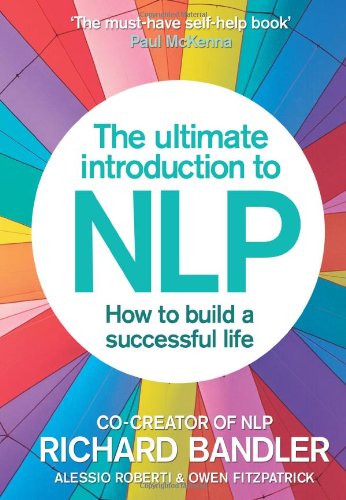The Ultimate Introduction to NLP Summary

6 min read ⌚
How to Build a Successful Life
If you watched “Arrival” last year, chances are you’ve already heard something about the correlation between the structure of your language and your worldview.
If not, here’s your chance to learn something more about a related theory. Of course, there’s a practical side too: NLP (Neuro-linguistic programming) can help you program your brain in a way even Buddha would envy!
And there’s a bonus: “The Ultimate Introduction to NLP” is co-authored by the co-creator of the psychotherapy.
That’s right: we’re drinking from the spring!
Who Should Read “The Ultimate Introduction to NLP”? And Why?
As we’re about to see, NLP is a method designed to help everyone who has any kind of problems. Consequently, whoever you are and whatever you’re doing – reading this book will certainly not be the worst thing you’ve done this week.
However, if you’re a psychology student or want to know more about NLP, then you’ve undoubtedly got the right book in your hands.
About Dr. Richard Bandler, Alessio Roberti, and Owen Fitzpatrick
Dr. Richard Bandler is an American self-help trainer and celebrated author of numerous psychotherapeutic books. While a student at the University of California, he co-created, together with linguist John Grinder, the NLP methodology. Since then, he has independently developed few related concepts, such as DHE (Design Human Engineering) and NHR (Neuro Hypnotic Repatterning).
is an American self-help trainer and celebrated author of numerous psychotherapeutic books. While a student at the University of California, he co-created, together with linguist John Grinder, the NLP methodology. Since then, he has independently developed few related concepts, such as DHE (Design Human Engineering) and NHR (Neuro Hypnotic Repatterning).
 Alessio Roberti is the director of the largest NLP organization and a “Master Trainer” of NLP. He has studied Bandler’s books for almost three decades and has coached many presidents and CEO’s. “How to Take Charge of Your Life: The User’s Guide to NLP” is another book he has co-authored with Bandler and Fitzpatrick.
Alessio Roberti is the director of the largest NLP organization and a “Master Trainer” of NLP. He has studied Bandler’s books for almost three decades and has coached many presidents and CEO’s. “How to Take Charge of Your Life: The User’s Guide to NLP” is another book he has co-authored with Bandler and Fitzpatrick.
 Owen Fitzpatrick became the youngest NLP “Master Trainer” when he received the distinction at the age of 23. Since then, he has participated in many seminars, and authored numerous articles on the subject.
Owen Fitzpatrick became the youngest NLP “Master Trainer” when he received the distinction at the age of 23. Since then, he has participated in many seminars, and authored numerous articles on the subject.
The Ultimate Introduction to NLP Summary
Even though it may sound SF to you, most of the time you are not exactly living your life consciously!
Not at all! You have just programmed yourself to do some things in a certain matter!
For example, habits are usually no more than an exe file you run under certain circumstances. And then – you just act accordingly. You’re not contemplating them, you’re not thinking about them – they are just hardwired into your brain.
Well, so is everything else!
You see, your brain gets you through your life by creating mental maps of the world. However, these maps are not exactly perfect. Just like the real maps, they too have three fundamental flaws.
First of all, they are not complete. When you create your mental map, you ignore or delete many things that actually exist.
Secondly, you generalize. Even though the world is full of details.
And, finally, you distort some facts because you don’t have enough information.
The most serious problem, however, is that no two mental maps are alike. So, whenever you have a discussion with someone, what you’re starting with is a differing vision of the world. Cue misunderstandings, anger, sadness, broken hears…
So, how do you mend this?
Logically, by correcting your map. And there are many ways to do this.
First of all, you need to update and expand it.
These two usually go hand in hand. Updating and expanding your mental map may seem hard at the beginning, but it’s really not.
For example, if you are rejected by a loved one, it would be a serious mistake if you update your mental map with a “no more love affairs ever” ocean of tears. That results in a contraction of your mental map which will certainly not help you find the love of your life.
Secondly, you need to connect isolated areas in your mental map.
This is called anchoring and it’s a good way to fight phobias and fears. Say, you’re afraid of spiders. If so, link this experience with something you like, such as candies. In time, you’ll think of candies every time you think of spiders. And things will get dramatically better.
The power of positive thinking is no joke!
And if you anchor just the right things in your brain to each other, you will be happy enough to make other people happy. Because, emotions are contagious, and because, no matter how sad you are, smiling people may make you feel better.
You know why?
Because you’re still, in a certain way, a child! In other words, children learn things by mimicking adults. And adults join a community by mimicking the behavior of the community! And this fact is your shortcut to better friendships and relationships!
Just think about it:
You can get closer to someone if you analyze his behavior better and repeat it. Sometimes, you won’t even need to: when you click with someone, it’s because you don’t have to mimic anything. Not only your mental map is fairly similar to the one you’re talking to – your communication styles match as well!
While on the subject of analyzing, it’s a good idea to analyze someone’s generalizations. This is how you’ll gain a better understanding of someone’s mental map. And even more: that’s how you’ll update and expand both his and yours.
You can’t doubt your beliefs until someone questions them!
Hopefully, this summary has questioned yours.
If so – time to doubt and improve them!
Key Lessons from “The Ultimate Introduction to NLP”
1. Your Mental Map Is Not Perfect: Improve It
2. Anchor Feelings and Experiences
3. Question Everything – the Right Way
Your Mental Map Is Not Perfect: Improve It
You might have spent years and years on building your mental map. It doesn’t matter: it will never be perfect! Don’t ever forget that!
Because things are happening every single moment, and because you need to update your mental map daily. So, reserve few minutes to bring your mental map to date every evening. And when you do that – be detailed and try to expand it!
Generalizations and contractions won’t do!
Anchor Feelings and Experiences
Your brain is a kind of a cinema! Make the world-watching experience a little better, by adding the right color, or adjusting the tone. For example, listen to your favorite songs every time you do the dishes. After few months – and this is not a joke – you’ll like to do the dishes.
Question Everything – the Right Way
People live in communities. And communities are built on shared mental maps. In order to create them, you’ll need to take part in the sharing experience.
The best way to do this is by questioning yours, and other people’s beliefs. But, be creative and thorough with your questions. E.g. if someone says to you “everybody is doing it” ask, justifiably so, “who is everybody?”
Like this summary? We’d Like to invite you to download our free 12 min app, for more amazing summaries and audiobooks.
“The Ultimate Introduction to NLP” Quotes
The core message of this book is that there are precise tools that can help you to take control of your life. Share on X There is a huge need in the world today for a change in mentality. There is a huge need to inject hope for a better world. Share on X The map is not the territory: your understanding of the world is based on how you represent it (your map), not on the world itself. Share on X Understand and respect others’ maps. Share on X You begin with your thoughts, then thoughts become actions, actions become habits, and habits become part of who you truly are. Share on XOur Critical Review
“The Ultimate Introduction to NLP” is the only book you’re ever going to need if you’re interested in finding out what NLP is and how NLP can help you. You might have heard of Paul McKenna. Well, he says that it’s “the must-have self-help book”!
However, we beg to differ. It’s not that “The Ultimate Introduction to NLP” is a bad book. It’s just that it has a fancy title to describe some things you might have already been aware of before even reading it.
Nevertheless, NLP or no-NLP, some of its advices are good.
How do we know?
Well, some of them have worked for us. You can try them too.
In that case – good luck refining your mental map!








